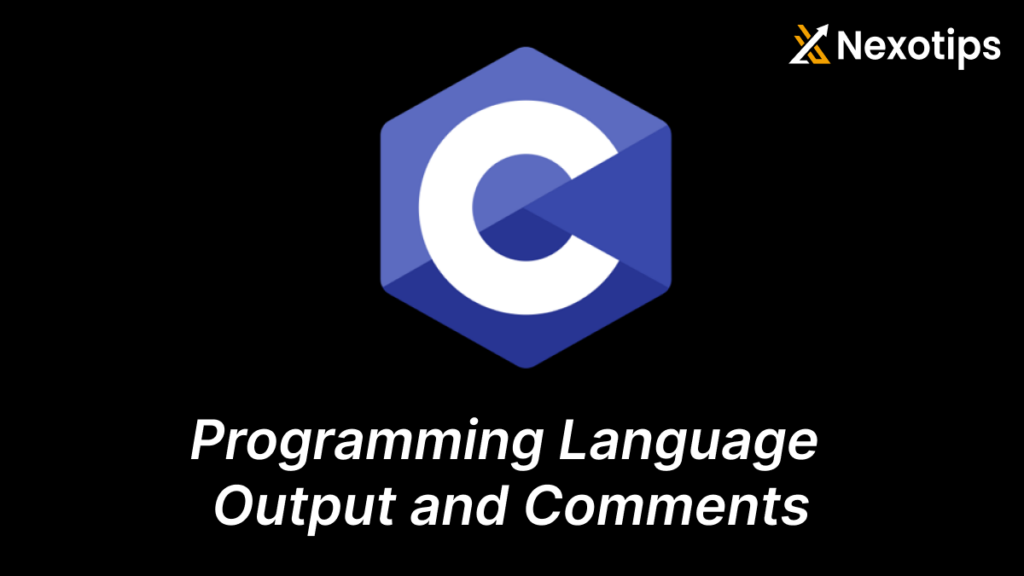C programming
In the realm of programming, C language holds a pivotal place due to its efficiency and control over system resources. For beginners and seasoned developers alike, understanding the nuances of output and comments in C programming is crucial for writing clear, maintainable, and effective code. This guide aims to delve deep into the mechanisms of output and comments, providing examples, best practices, and SEO-friendly tips.
Index.
1. Introduction to Output in C
Output is a fundamental aspect of any programming language, enabling developers to communicate with the user or debug the code effectively. In C programming, the primary function for generating output is printf().
printf() Function
The printf() function is part of the standard input-output library (stdio.h) in C. It allows you to print formatted output to the standard output, typically the console.
#include <stdio.h>
int main() {
printf("Hello, World!\n");
return 0;
}Format Specifiers
Format specifiers are placeholders within the printf() function that denote where and how to format the values. Common format specifiers include:
%dfor integers%ffor floating-point numbers%cfor characters%sfor strings
#include <stdio.h>
int main() {
int num = 10;
printf("The number is %d\n", num);
return 0;
}Examples of printf()
Let’s look at a few examples to illustrate how printf() can be used:
#include <stdio.h>
int main() {
int age = 25;
float height = 5.9;
char initial = 'J';
char name[] = "John";
printf("Name: %s\n", name);
printf("Initial: %c\n", initial);
printf("Age: %d\n", age);
printf("Height: %.2f feet\n", height);
return 0;
}2. Understanding Comments in C
Comments are non-executable parts of the code that help in making the code more understandable. They are essential for documentation and explaining complex logic.
Single-line Comments
Single-line comments start with // and continue to the end of the line.
#include <stdio.h>
int main() {
// This is a single-line comment
printf("Hello, World!\n");
return 0;
}Multi-line Comments
Multi-line comments start with /* and end with */.
#include <stdio.h>
int main() {
/* This is a multi-line comment
spanning multiple lines */
printf("Hello, World!\n");
return 0;
}3. Best Practices for Using Output and Comments
- Clarity and Brevity: Ensure your comments are concise but informative.
- Relevant Information: Only comment on code that is not self-explanatory.
- Consistent Style: Use a consistent commenting style throughout your code.
- Avoid Over-commenting: Do not comment on every single line; focus on complex logic or important sections.
- Meaningful Output: Ensure your output messages are clear and provide relevant information.
4. Common Pitfalls and How to Avoid Them
- Ignoring Format Specifiers: Mismatched format specifiers can lead to incorrect output. Always double-check.
- Overuse of Comments: Too many comments can clutter your code. Use them judiciously.
- Neglecting Edge Cases: Ensure your output logic accounts for edge cases and handles errors gracefully.
- Hardcoding Values: Avoid hardcoding values in
printf(). Use variables and format specifiers instead.
5. Advanced Output Techniques
Using Escape Sequences
Escape sequences are used to represent special characters within strings. Common escape sequences include:
\nfor a new line\tfor a tab\\for a backslash
#include <stdio.h>
int main() {
printf("Hello,\nWorld!\n");
printf("This is a\ttab.\n");
return 0;
}Formatting Output
To format numbers with precision, you can use format specifiers with additional parameters.
#include <stdio.h>
int main() {
float num = 5.12345;
printf("Formatted number: %.2f\n", num); // Outputs: 5.12
return 0;
}6. Conclusion
Understanding output and comments in C programming is foundational for writing efficient and maintainable code. By mastering printf() and adhering to best commenting practices, you can enhance the readability and functionality of your programs. Remember to keep comments meaningful and output informative, ensuring that your code remains clean and professional.
SEO Tips:
- Use the focus keyword “C programming output and comments” throughout the blog.
- Incorporate related keywords like “printf() in C”, “C comments”, “output formatting in C”.
- Include subheadings (H2, H3) with the focus keyword.
- Use code snippets to provide clear examples.
- Write a meta description summarizing the blog content with the focus keyword.
- Use internal and external links to related content.
By following these guidelines, you can create an SEO-friendly, informative, and engaging blog post on output and comments in C programming.
Other’s: Syntax In The C Programming Language: Understanding The Basics.
